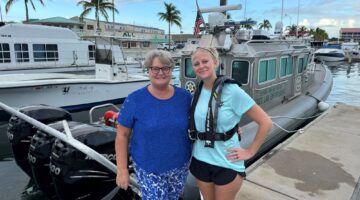As temperatures rise, snook have expanded range north, new study finds
By: Samantha Murray
Snook, the popular game fish native to the tropics, has been expanding its range and reproducing farther north, according to a new study published this week by researchers at the Florida Fish and Wildlife Conservation Commission and the University of Florida.
The likely reason? Warming temperatures due to climate change have allowed snook, which are highly sensitive to cold, to survive and spawn at more northern latitudes.
The study focused on Cedar Key and Lower Suwannee River areas, which are north of snook’s historic range, said Charles Martin, one of the study’s authors and an assistant research professor of fisheries and aquatic sciences based at the UF/IFAS Nature Coast Biological Station.
The study’s findings offer clear evidence of a trend anglers have also recognized.
“Recreational fishing along the Nature Coast is an important economic driver in this region, and a lot of tourists come to this area to fish,” Martin said. “I know some fishing guides in the region now target snook, so I am curious what impact this expansion will have on local economies of these small towns along the Gulf coast.”
While the snook’s expansion may be exciting news for anglers, it’s not clear what competition with snook will mean for native fish, a possible focus of future research.
“Snook are no doubt being targeted by recreational fishermen, and they are excited to have access to the snook fishery in this region,” said Caleb Purtlebaugh, research biologist with FWC and the study’s lead author. “I wonder what impacts the range expansion of snook may have on other recreational species in terms of harvest and species competition for similar resources.
The researchers say snook are just one example of a species moving into higher latitudes due to climate change.
“Many species are migrating northward with a warming climate, including plants, such as mangroves, as well as fish, birds and others,” said Mike Allen, professor of fisheries and aquatic sciences, the director of the UF/IFAS Nature Coast Biological Station and one of the study’s authors. “We focused on snook in this study, but the same pattern is happening with other species and other locations.”
The researchers compared two decades of local climate data with the number of snook recorded in fisheries sampling over the same period and region. They found that as local temperatures rose, so did the population of snook.
Sampling data also showed that snook began reproducing locally during this period. Early sampling efforts only caught larger adult fish, which scientists surmised must have moved into the area as adults. However, in recent years the researchers also found smaller, younger fish, a sign that snook had begun spawning locally.
“It’s a surprise how quickly the population became established in this region with natural reproduction now every year the past five years, and no historical records suggest they were established and reproducing previously,” Allen said.
Furthermore, snook have not just been concentrated in a few areas, Purtlebaugh added.
“I was most surprised by not only the exponential increase in catches in recent years, but also by how quickly the spatial distribution of snook expanded in the Suwannee estuary,” Purtlebaugh said.
For example, when ocean temperatures fall, snook have been known to retreat into warmer freshwater rivers and springs along Florida’s gulf coast. The study’s sampling data show an increase in the number of snook caught in these “thermal refuges” during the winter, evidence that snook are using these places to escape the cold.
The researchers focused on the Nature Coast region because it contains an ecological transition where mangrove forests, like snook, are also shifting north. This makes the Nature Coast is an ideal place to study the impact of climate change on coastal areas, Allen said.
Studies like these are made possible by long term data collection and collaboration among state and federal agencies and the university, Allen said.
“This study represents a great partnership with FWC and other agencies we plan to continue well into the future, evaluating the impacts of changing species distributions and changing habitats on the estuarine food web and the natural resources they support,” Allen said.
There are still many questions about snook in the Gulf, the researchers said.
“Through FWC’s partnership with UF, we hope to address future research needs that were highlighted in this study,” Purtlebaugh said. “We hope to answer questions such as: how do snook utilize a large freshwater system like the Suwannee River; can we identify spawning locations and does timing differ from southern estuaries; and how do discharge patterns from the Suwannee River influence timing and movement by snook?”
[livemarket market_name="KONK Life LiveMarket" limit=3 category=“” show_signup=0 show_more=0]







No Comment